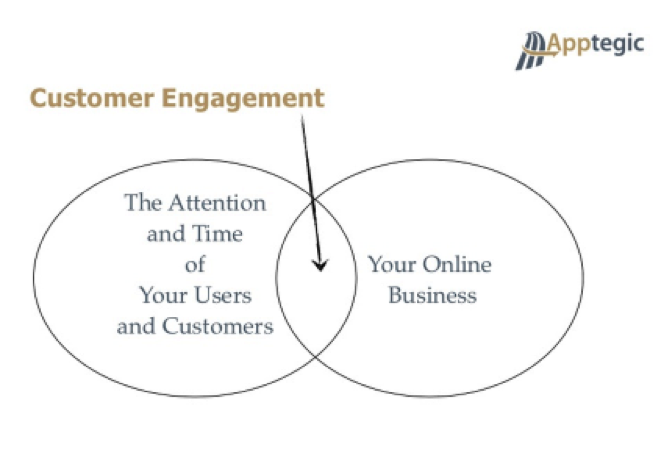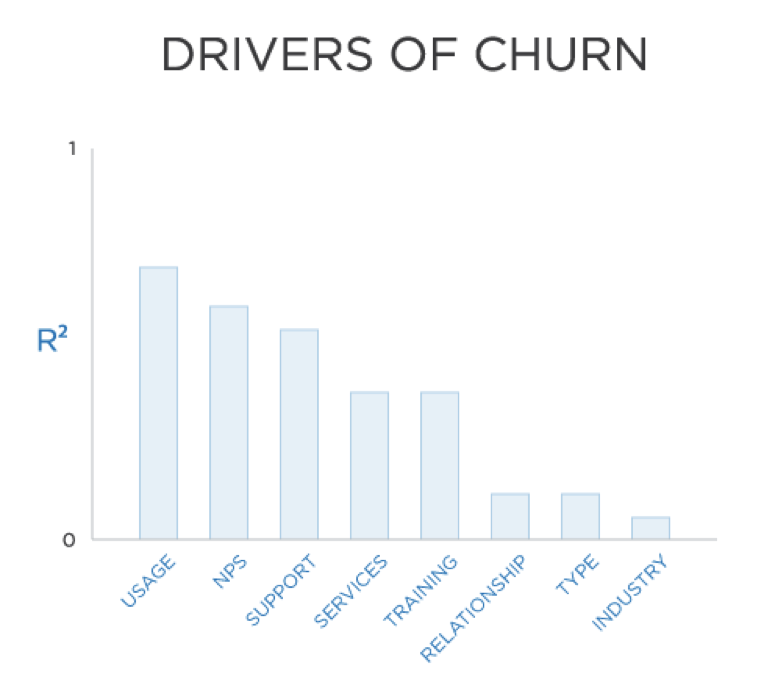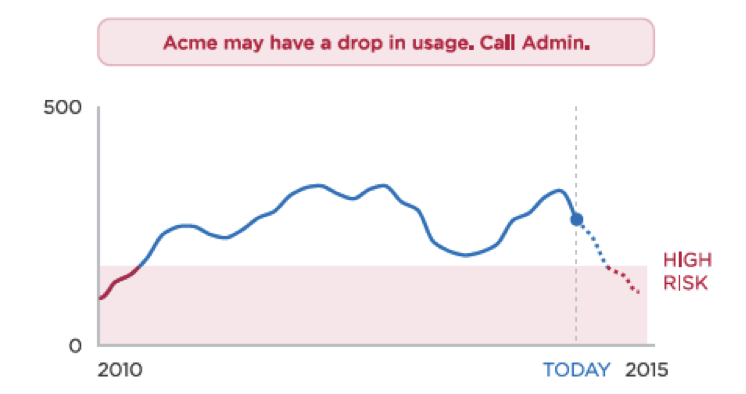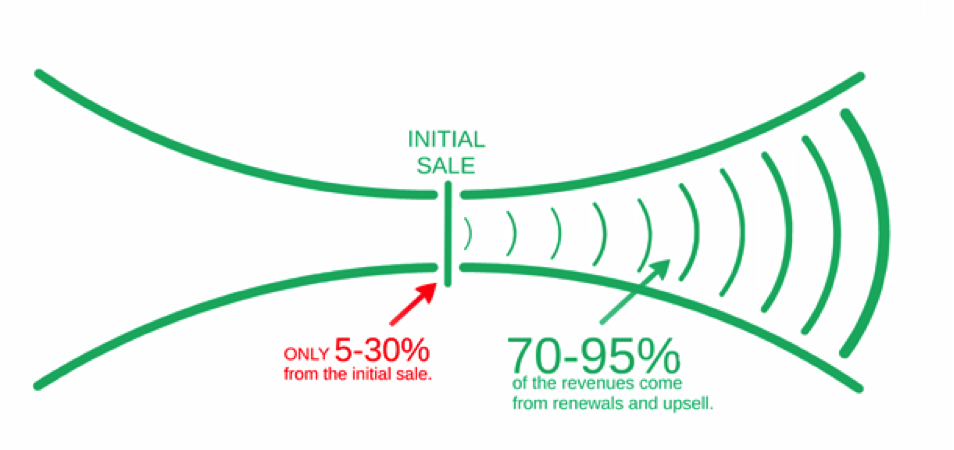It’s never fun to lose customers. To lose customers is to lose money.
In SaaS, we call it churn rate. Churn rate is defined as “the percentage of subscribers to a service that discontinue their subscription to that service in a given time period.”
Most of the pablum you read on the topic will tell you “have a great product!” or “awesome customer service.” I’m all for great products and killer customer service, but I’m also assuming that you’ve got the basics down. It’s time for the advanced tips.
What you’re about to read is eight advanced tips. You’re going to discover strategic methods for avoiding the profit-killing falloff of loyal customers. Here’s what you need to do.
1. Ask for engagement.
Saving your SaaS customers is no simple task. A list of “hacks” or “tricks” on the topic won’t cut it. That’s why I’m leading off with a highly advanced technique built on the topic of engagement.
In SaaS, engagement happens when a customer uses and gains value from the SaaS. Apptegic defines “customer engagement” as the nexus of a customer’s time and attention and your product.
Lincoln Murphy makes his definition even broader: “ Engagement is when your customer is realizing value from your SaaS.”
However you choose to define it, engagement matters. Why? Because a customer who doesn’t use your product isn’t going to keep paying for your product. Think about it. If you pay $90/month for a home cable subscription, but nobody in your home uses it, you’re going to cancel. Likewise, if your customers are not engaged — not using the service for which they are paying — then they will cancel.
Raw statistics prove this point. Totango surveyed over 1 million SaaS customers. Almost every cancellation was “preceded by a period of non-use” (source).
Lack of usage is the number one churn driver, according to research from Bluenose.
If a customer is actively using your product, they are unlikely to cancel their service. If, on the other hand, the customer doesn’t use your product then they’re going to pull the plug. It’s that simple.
To prevent churn from customer disuse, you should do several things. First, you need to measure engagement. One way of measuring engagement is to track product usage data. If a customer regularly uses your product, you have nothing to worry about. If, on the other hand, the customer’s usage level drops off, you need to find out why it dropped and what to do about it.
Every SaaS has different methods of tracking customer engagement and usage. Take a look at the illustration below. For Acme company, a dip in SaaS usage triggered an alert. The account is now at risk of cancellation because that customer’s usage data decline significantly.
One simple engagement metric is login regularity. If a customer doesn’t log into their account for a period of three weeks, their usage level may be declining. This is the kind of information that could prove valuable as you analyze churn rate and identify metrics that correlate with reduced engagement.
Based on your engagement data, you need to make adjustments. The idea here is to encourage engagement. You can and should adjust the features and functionality of your product, but the most valuable way to retain the customer is by contacting them directly. Whether it’s an automated email or a personal phone call, make it your goal to get the customer’s time and attention.
When you secure the customer’s time and attention, and bring it back to your product, you will increase engagement. And once you increase engagement, you’ll lose far fewer customers.
2. Be proactive about expired or cancelled credit cards.
Engagement is a wide arena. There are dozens of ways of tracking engagement, measuring engagement, and asking for engagement. I want to take you from the vast field of engagement to the narrow field of avoiding cancellation via credit card expiration.
If your SaaS uses recurring billing on credit cards, then this is a highly significant point. First off, here’s what you need to know about credit cards.
- Most credit cards expire every three years.
- This means that, on average, 3% of your card subscriptions will expire in a given month, or 36% of your card subscriptions will expire in the course of a year.
With these kinds of numbers, you will face expired credit cards on a regular basis. Expiration information is part of every card data, so you have this information to use as you wish. How should you use it?
Tell customers that their card is going to expire before it actually happens. Send an email or give them a phone call several weeks or months before the expiration date, reminding them that the card will expire. Some dunning management services can perform these functions on your behalf.
Often, credit cards are rejected because the card has been cancelled not just expired. Many credit card providers have highly sensitive triggers that will flag (and cancel) a card for seemingly small reasons. On this subject, Healy Jones writes, “I’ve decided that the biggest threat to a software as a service startup isn’t anything sexy or mysterious. No, it’s the annoying fact that so many credit cards get cancelled by no fault of the user.”
Whether cancellations, blocks, expirations or some other weird credit card issues, it’s important to stay on top of it. Dunning emails may not be the most exciting part of SaaS customer retention strategy, but they sure are important.
3. Always be selling.
If you haven’t realized it by now, as a SaaS company, you must always be selling. VentureBeat puts the issue bluntly:
SaaS companies are literally always selling, because they have to keep the customer from hitting the cancel button each month
What does it mean to “always be selling” as a SaaS? It means several things:
- Create unparalleled customer service. I told you that I wouldn’t be overly simple in this article, but I need to say it. Your customer service is as much a part of your SaaS as the software itself. After all, that’s why it’s called “software-as-a-service.”
- Provide quick deployment and rapid configuration. Most SaaS sales cycles are really short, which is exactly what the provider and the customer want. Customers who choose SaaS do so to save time, deploy quickly, and operate with uninterrupted flow of business operations. Your ability to deliver on these fronts is part of the entire method of selling the product.
- Be scalable. When your customer’s business grows, grow with them. Don’t reinvent the sales wheel when the customer needs to add users or functionality. Create an experience that ebbs and flows naturally with the needs of the customer.
- Make upgrades easier. One of the most straightforward ways to always be selling is to always be upselling. According to InsightSquared, “upsells are the Holy Grail” of SaaS companies. While that may seem like an overstatement, consider that the SaaS companies that grow the fastest rely on upsells to fuel the growth (as high as 35% ACV from upsells).
Garrett Moon wrote truth: “When our number one goal is to help our customers succeed, we may have already designed all of the sales strategy we really need.” That’s all about selling smart and avoiding annoying cancellations.
Let’s just make sure that we’re keeping our eye on the sales issue. The minute we start to let go of sales, we start to lose the edge that keeps customers coming back for more.
4. Improve the features that really matter.
As your SaaS matures, you’ll find that some features are more important to your customers than others. As soon as that becomes apparent, make sure you’re improving the quality and power of those particular features.
If you can make the best feature of your SaaS even better, then you’ll keep your customers from ever needing to cancel.
Forentrepreneurs calls these features “sticky.” One sign of a sticky feature is one that embeds itself in the daily workflow of the customer. Not only does the customer become highly engaged (remember point one!), but they also become dependent upon that feature, thus lowering churn.
5. Upgrade the customer experience.
It’s a mistake to think that your SaaS customers are in it only for the software. They’re in it for the experience, too.
To persuade yourself of this point, consider how much of your SaaS is the service part. This includes the interface the software, its functionality, speed, features, cost, purchase process, renewal process, correspondence, customer service, and everything else that has anything to do with the entire SaaS. It’s an experience. All of it.
In a CMS article, the authors discussed “SaaS Support Best Practices.” The theme of the article ended up revolving around the customer’s experience. A negative experience can quickly derail a customer, whereas a positive experience will retain that customer.
By providing a great focus on experience you can retain customers who are teetering on the edge.
6. Give upgrades, discounts, or random rewards.
One way to increase eagerness with your service is to have a sense of built in surprise or expectancy.
Surprising customers is a proven way to increase satisfaction. In controlled tests, researchers discovered that when waiters gave customers a small gift (such as a mint), tipping was on average 23% higher for customers who were surprised by the gesture (source).
Columnist Peter Economy reports, “the secret to delivering great customer service is to give your customers a surprise–something they didn’t expect. It’s those unexpected experiences that leave customers with a story they are eager to tell.”
What kind of surprises can you give? Choose something that is relevant to your product, but make it meaningful. Here are a few options.
- Free features
- Extra storage
- One free month free
- A percentage discount for a year
Surprising and delighting customers is solid business strategy. As a Salesforce guide puts it, “SaaS companies must delight their customers day after day to keep them coming back.”
7. Be totally transparent.
Many customers are skeptical of SaaS companies. Here’s why.
The average customer sees a piece of software that costs a lot, but doesn’t seem to require a whole lot of overhead on the part of the provider. Sure, there’s some development and marketing cost, but where is all the customer’s hard-earned money going? The skeptical customer raises an eyebrow, too, over any possible security breaches and opaque contract language.
There’s one thing you can do to change the customer’s skeptical stance: Be totally transparent.
Recent security breaches have taught the general public that they can’t trust big data companies. Heck, they can’t trust any SaaS, for that matter. If their credit card information and social security number are just one click away from publicity, then why take the risk?
Transparency is the only way to overcome the skepticism and to build back trust. Here are some of the specific ways you can create an attitude of transparency:
- Notify users of downtime.
- Give customer advance notice of pricing or contract changes.
- Explain to customers where their money goes.
- Answer any questions that prospective customers have.
- Make it easy for customers to cancel service.
Once you start achieving full transparency on every level of the business, then you start to gain the trust of your customers and prospects. The moment you reach that tipping point, your customers won’t even think of turning away.
8. Focus on retention optimization (more than conversion optimization).
For all the attention on conversion optimization, there’s a huge source of optimization that is right in front of you — retention optimization. Instead of the traditional A/B testing, retention optimization uses metrics such as user testing, customer surveys, and other customer-focused data.
Admittedly, customer retention optimization isn’t the exact science that CRO is. Tim Ash calls it “post-conversion CRO,” and explains that failing to optimize for retention is a huge missed opportunity. In SaaS, it’s deadly to overlook your retention strategy.
Retention is not so much about optimizing the product as it is understanding the user. The Customer Success Association writes, “ It’s what you don’t know about your customer relationships that can cause you to lose them.”
While new users are great, retained users are even better. The vast majority of your ongoing revenue stream is from existing users. Take a look at how this breaks down:
Marginal differences in retention rate have a huge cumulative impact. SaaS-Capital provides the following case study, described by the Customer Success Association. The scenario is two SaaS companies selling only software subscriptions. All other things being equal, this example proves the power of retention:
The only difference between them is that one has a customer retention rate of 95%; the other’s only 80%. At the end of 5 years, the difference in bottom-line company valuation between the two was $15 million dollars. Along the way, the company with the 95% retention rate also had increased revenues to work with, up to $24K per month.
Simple retention rate improvements will powerfully impact your company.
Conclusion
VentureBeat describes the subscription-based model of business in the following way:
For consumers, subscription connects them with the best brands, products and services they love and need over a certain period of time. Those brands have to truly resonate with consumers, which is why they’re willing to commit to a recurring payment.
Did you catch that? “The best brands…services they love and need.”
The sum total of the above points is that your brand develops confidence. This level of brand confidence perpetuates itself. You become a “best brand” in the mind of a customer. You become the SaaS “they love and need.” This type of customer loyalty, in turn, builds the brand confidence even more.
A brand with confidence is a brand that inspires confidence in its customers. They respect it. They stick with it.
Successful SaaS companies build more than a great product. They build a brand that is strong and confident. That alone is reason enough for a customer to stay.
What is your advice for maintaining your SaaS customers?




Comments (2)